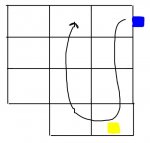- Apr 27, 2009
- 1,616
- 399
- 63
It's well established that Pit Zerkers are the kings of magic find. The SPF Hall of Records and recent Magic Find Olympics will attest to their efficiency, yet some still prefer an Ancient Tunnels (AT) sorceress. That might be because of play style, an affinity towards spells, or a tendency to go with the underdog. However, @Owlie's new magic find efficiency spreadsheet, which factors in the number of minion and regular monster kills, indicates that the gap isn’t as wide as was once believed. Another reason to play an AT Blizzard sorceress is if you have just (re)started as they are much more forgiving gear-wise than Pit barbarians.
Table of contents:
I. Cartography
1. Map Variations
2. Map Density
3. Map Assessment
4. Shrines
II. The Blizzard Sorceress
1. Stat and Skill Distribution
2. Equipment Milestones
3. General Gameplay Tips
III. Further Improving Run Times
1. Keyboard Shortcuts
2. Inventory Layouts
IV. Miscellaneous and Speculative
1. Improving Save and Load Times
I. Cartography
I've searched far and wide, but couldn't find any in depth information on AT. This was my main motivation for writing a guide which focused on rolling and assessing maps.
1. Map Variations
Rolling a good map can be both time consuming and sometimes frustrating, even more so if you aren't exactly sure what you're looking for. I've had this issue for a long time and decided to explore the subject thoroughly, hopefully learning much in the process. Although I haven't found all the answers I set out to unravel, I've made some interesting and useful discoveries. I hope they prove valuable to you as well.
Through my research, I've established that AT maps can consist of a varying number of rooms. This number ranged from 10 to 12, and I found each as likely to be rolled while examining more than 50 different maps. The collected data also indicates that spawn density does not correlate with map size, making the "10 room" maps most likely top contenders. I've come up with a naming convention for maps by counting the number of rooms and their "square area", which is basically counting the rooms on both axis and multiplying the results. However, the number of rooms alone is not enough to predict a map's success, their layout should also be taken into account. Before continuing to ramble, I'll include an example as it should make things much clearer.
Featured is a "11-12 type" map, it has 11 rooms aligned in a way which almost form a square (4x3):

The observed map area never exceeded the 12 to 30 square range and likely cannot due to the maximum room count and the way segments have to fit together.
In my experience, efficiency wise, the tightly packed maps performed better. Simply because everything was much closer together. However, a spread out map's spawn patterns may make completely ignoring large sections of it possible, thus making it competitive. This falls under the area of density distribution.
2. Map Density
Now we know a bit about map layout, but still need to determine how to properly assess map density.
Contrary to what you might find in various wikis and forums, the actual number of unique bosses or champion groups (packs) in the AT is not 6-8. No matter how you count the mandatory spawn near the chest. The actual number, chest spawn included, is 3-9 and varies from map to map, reliant on unknown but consistent game mechanics. During map assessments, I've seldom come across maps which could spawn 9 packs, while several sometimes rolled the minimum of 3.
At some point, I've actually started extracting and documenting individual rooms. Although I've stopped this direction of research, I've concluded that there are no more than 30 unique segments which comprise an AT map. I've sorted the rooms by the orientation of the hallway(s) and started noting the average density each one produced on different maps. I've stopped in the middle of updating my marking scheme as I've come to the realisation that there's nothing special about individual rooms. This was easily observable in instances where one room would be very rich in spawns on one map and really poor on another.
Individual segment catalogue (incomplete):

The exact mechanics appear to be unknown and I've come to terms that I'll not be the one who discovers the inner workings behind density distribution. This might have been uncovered at some point, and lost in the void that is the Internet, and may yet again be revealed by code diggers.
And that time has come! @Fruit brought to light those exact inner workings. I'll start with an image and explain what's going on.
This is what happens when you go down the drain:
segments_spawned will equal 2 (because the initial segment is also counted), while total_segments is 11 for this map.
This gives segment #4 18,18% change to upgrade any of it's spawns. Let's assume segment #5 is next. The following would apply: 3 * 100 / 11 = 27,27%, etc. This will continue until the minimum upgraded monster count condition is satisfied, which is 4. Afterwards, a simple 6% chance is applied to each consecutive spawn until the maximum count reaches 8. The maximum count does not include the mandatory chest spawn, this is why some maps are able to exceed the cap and give 9 packs. It's also very important to note that each champion counts individually. So not only are their drops worse, but they'll eat up the maximum possible upgraded packs and there's nothing we can do about it.
With all this in mind, I drew the following conclusions:
3. Map Assessment
With all of this information we should be able to confidently assess AT maps. I've developed a process which should make this as painless as possible while also making sure you do not re-roll a good map in not knowing any better.
The first step is to roll the best possible Rouge Encampment layout and Lost City waypoint, bonus points if Cain is not inconveniently placed behind the hearth.
Ideal Rogue Encampment layout:
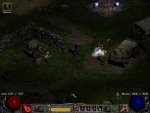
This type of map makes it possible to access the waypoint with the least amount of walking, using Telekinesis from the position shown in the image. Cain's location is important if you do not rely on manually identifying items, but do so after a run. The distance from the Lost City waypoint to the trap door can be as little as one teleport, while this is ideal, 3 should be perfectly acceptable. Another thing to note is that you should favour maps which do not require you to teleport to the south. Since the user interface is organised in a way which obstructs a part of the screen teleporting southwards will usually be less efficient than going north, while east or west is preferable to both because more screen space is available horizontally.
Finally, we come the AT map itself. As mentioned earlier, a dense layout consisting of 10 rooms is likely going to come out on top. Ideally, your first teleport will take you to a room which has the first spawn so you'll spend as little time as possible from starting a run to killing the first pack. If you decide the layout is acceptable, take a screenshot of the minimap and enlarge it, then draw a grid over it. It may seem daunting at first, but you'll quickly realise that it's only difficult to make a mistake. This is because the game handles the rooms exactly like a grid. I've easily managed all of this in Paint, it should be a breeze with a superior tool.
Drawing a grid:
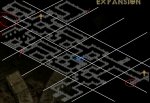
Enumerate the rooms the way you are most likely going to be running through them as this should make the assessment process easier. When done, you can actually do some runs! I found it about the same time-wise to record a video of my runs or to tab and note the packs as I go. Both methods take time and are prone to errors, but those should even out when working with a larger sample size.
Documenting runs:

10 runs should already be a good indicator of what you're dealing with. If the map's chest room is adjacent to it's entry and it spawns only 3 packs more than once (chest pack included), you should reroll. A map with that type of layout probably can never spawn 9 packs. Once you've documented 20-30 runs check the average density, if it is below 5.5, you should look for another map. Your goal is to find one which will spawn 6 or more packs on average. All of my maps, which had an average density of ~6, were not below the 5.5 mark even after just 10 runs. 20 runs were usually enough to accurately predict the final density score.
Once you've documented a 100 runs, calculate how many packs each room spawned and add this information to the grid. This will help determine your run route which will hopefully resemble something like the following image.
In white, the percentage of pack occurrence, while yellow stands for pack % with the chest spawn excluded:

I though that this was a very good map, but I know better now and no longer regret rerolling it. A "10-15 layout" with three completely irrelevant rooms, and an average density of 6.06, likely in the 1.95 Fabian's range. There were no dead ends you had to visit and no need to double back. The ideal path, though a bit difficult to pull of correctly, would have probably been clockwise, visiting the chest and hitting the high spawn rate rooms first. Unfortunately, the chest room would get spawned the moment you entered the dungeon ensuring that the map would never be able to upgrade 9 spawns.
You don't necessarily want the chest room to be at the end of the run, but you certainly don't want it to spawn early. Try to find a path which will spawn at least 4-5 rooms before the chest room is in range. During focused runs, you can count the number of packs you kill and see if you reach the maximum or maximum -1 your map can spawn by clearing only 2-4 segments, then save and exit immediately. This way no time is wasted teleporting through empty rooms just to reach the chest pack.
When you are satisfied with the map's layout, density, and "feel", the only thing left is to time your runs. The ultimate test will vary between maps, individuals, depends on the hardware you are using, some software to make this game run smooth in 2018., what you ate for breakfast, and the alignment of the planets... As rule of thumb, a 40s run with an average density of 6 is already an excellent result and will, on average, net a Tyrael's might in 745 hours, when running with 500 MF.
Remember that it takes a lot of practice to efficiently run a map. My first "official" go at this map clocked in at 38s per run and it took 3 more 100 run batches to bring it down to 31.5s, which would likely improve if I'd continued running the map.
Here's a quick summary of what to look for:
Still, there are downsides. Like spawning stuff in tight tunnels, mostly room #4. Those are difficult to kill with blizzard and slow me down. Also the first pack, which is present in almost every run, is behind a pillar and I have to guess where to shoot to kill it. Therefore, I believe an even better map is possible, but I wont be re-rolling this one any time soon
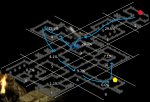
4. Shrines
I could barely find any mention of them in regards to MF runs so here are some bits I've gathered:

I jest, but even though a fire shrine can't kill you as it only halves your health (rounded up) it may easily contribute to casualties. So be careful when activating, but you should still examine those unlabelled because they might roll into monster shrines which produce either a unique or a single champion if there's a normal monster nearby. Although I cannot attest to their drop odds, the converted monsters should be fully capable of dropping TC87 items. However, you should also take into account that successful upgrades from shrines increment the total packs count and can actually lower your overall density, unless you use them after you've activated all of the segments you'd normally run. This could make a "10 pack" run possible.
As interesting as shrines may be, you should also learn to ignore them most of the time. Only activate the ones you need, when you don't have to go out of your way to do so.
This wraps up the map rolling section of the guide. Coming next are guidelines on improving your AT runs.
II. The Blizzard Sorceress
I'm not a hardcore player and you'll probably get your sorceress killed following my advice, as I do, frequently.
1. Stat and Skill Distribution
If you are just starting out, Shiver Armor could be of use, but should be replaced by Battle Command and Orders once you make Call to Arms. The rest of the skills are to be distributed so that:
Playing with runeword mode? You'll want Spirit, so that's 156 strength, usually 144 when factoring in Harlequin and War Traveler's stat gains and the rest goes into vitality. No RWM? Using the alternative equipment setup below, you'll need at most 93 strength to use the War Traveler boots.
2. Equipment Milestones
You can run AT with pretty basic gear, but there are a few difficult to obtain items which will dramatically increase your efficiency. The first one you'll likely manage is a Call to Arms, by the time you have one or can cube an Ohm rune, you'll probably be close to having a Tal Rasha's belt, armor, and amulet. The final piece of the puzzle is a Death's Fathom. Until then, use The Oculus if you can stand the random teleportation, while Heart of the Oak is a nice alternative if a Vex comes your way.
Your mercenary can get away with a plain Colossus Volgue Insight and anything for the armor and helm slot, but an ethereal GPA Insight, AP Fortitude, and a Chamed Andariel's Visage will make him both unkillable and very efficient in dispatching cold immune uniques.
The biggest difference will you run with 63 or 105 FCR? 105 FCR is going to be slightly faster, at the cost of MF. It also feels a lot smoother. Here's an example 63 FCR setup:
Maxing lighting resists shouldn't be an issues since the gear's got you covered, but cold resists should also be as high as possible to avoid situations like this one.
A very dead sorceress:
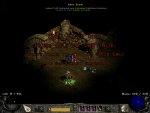
Just look at that thing, creeping around with a sliver of health. A Cold and Lightning Enchanted unique with Conviction will blow you up before you even realise what's going on. Blizzard will frequently put such a monster into hit recovery and each time this happens the boss will emit an invisible Frost Nova which also carries lightning damage. And if the monster is cold immune, your mercenary will happily put it into hit recovery for you.
While a vanilla player's gear choices are somewhat limited, it's still possible to be highly efficient. The biggest difference is in not having access to Insight, but you can work your way around it by playing more careful as to not get mana burned as often. Unfortunately, I doubt a 105 FCR setup can come out on top without the RWM so you'll have to do with 63.
The best substitute for Spirit is Lidless Wall, most likely socketed with an Ist rune to offset the MF loss. Trade one Nagelring for a Stone of Jordan and the other for a FCR ring, preferably with mods like +strength, mana, magic find, resists. Insight should be replaced with a Reaper's socketed with a Shael or IAS jewel, if using a Chamed Andariel's, and Fortitude with Treachery.
I've briefly tested this setup on my latest map and it wasn't that far behind the one with RWM.
3. General Gameplay Tips
Hold down the "highlight items" key while teleporting to avoid getting stuck, and while casting Blizzard. Pit Zerkers may be mechanically difficult to play, but once you master the routine they and their skills are completely reliable. Blizzard however, never is, but you can make the shards hit sooner, or hit at all Avoid name locking and aim slightly to the side and below your target. By courtesy of @Fruit I've learned more about the spell, and it turned out it's a bit more reliable than I thought.
Avoid name locking and aim slightly to the side and below your target. By courtesy of @Fruit I've learned more about the spell, and it turned out it's a bit more reliable than I thought.
Blizzard is an area of effect spell which deals damage over time, but has a casting delay. Its massive damage, listed in the skill description, is per shard. Ideally, you should kill most packs with the first few shards, but this takes a lot of practice.
While individual shard x-coordinates are random, there are only 3 y-coordinates where shards land. This is best observed in Fruit's test.
Blizzard shard pattern:
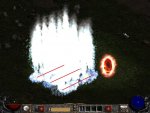
As far as I can tell, it doesn't matter in which direction Blizzard is being cast. The "y-lines" are always at this angle. This is probably what Blizzard sorceress players already instinctively figured out and are using it to aim.
When you get comfortable with aiming, you should also use Blizzard's timer to your advantage. Not being able to cast another Blizzard does not mean you are unable to teleport or shoot Ice Blast and Glacial Spike. Use the time to either explore the adjacent room or engage another pack. With enough practice you'll essentially be killing two packs at the same time, instead of waiting out the timer. Even if Blizzard doesn't kill the boss, it's bound to get at least some damage in and most of the minions will probably be dead making it very easy to finish the pack when you TP back to check the drop.
Once Ice Blast reaches ~2.7k damage, it can reliably 2 shot skeletal mages. This plays very nicely with casting a Blizzard on a more sturdy pack and then telebombing the mage.
Use telekinesis to activate the Act I waypoint. You can also open the AT trap door with it, but I don't find this useful because you can never be close enough to do it without moving first. If you are picking up gold (you shouldn't) also use TK, as well as to replenish your purple potion supply.
Remember that each mob should be approached differently, depending on its AI:
III. Further Improving Run Times
Still reading? Ok then, here are some tips to further boost your efficiency.
1. Keyboard Shortcuts
If your are still using the default key bindings or, gods forbid, the mouse wheel to cycle through skills (like I used to until recently) consider improving your efficiency by rebinding the default keyboard shortcuts.
Most people have their own preference, but a common approach is using QWERT and ASDFG for skills. Also remap the item highlight key from Alt to Space to avoid agitating your carpal tunnel.
It can take a long time to get used to the new keys and might feel terrible at first, but it gets better as you do more runs. Once you get used to them you'll never want to go back.
2. Inventory Layout
There are several interesting configurations, depending on what you want to pickup. If you like to check out circlets and jewelry, ID some rares, you should definitely go for 8 empty slots with an ID tome, might even add the cube for extra storage. This setup is more appropriate for a relaxed format, at the expense of having less MF.
Once I hit grail -4ish, I've switched to "cube runs" where the whole inventory is dedicated to MF charms. I keep 4 ID scrolls in the belt for emergencies, like when a Gheed's drops. The rest of the items I still pick up (grand and small charms, grailers, TC87 and highly sought after uniques, high runes) are tossed into the cube and dumped to the stash on the start of the next run. Another advantage of not having an inventory is that you can't accidentally pick up junk.
IV. Miscellaneous and Speculative
Haven't had enough? Guess it's time to make your runs supersonic.
1. Improving Save and Load Times
Having a modern computer with an SSD will definitely improve these. There are a few more tricks though, which I'll separate into:
a) definitive
In the end, remember it's all about the journey... or something along those lines...
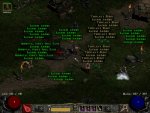
I'd like to thank everyone who I pestered with questions and bounced crazy ideas off while working on this guide (
@Fruit, @GalaXyHaXz, @Owlie), as well as the whole SPF community for what it is and stands for. I hope we all find our Tyrael's in the end.
Created: Oct 29, 2018
Edited: Aug 3, 2019
Moved: Apr 5, 2020
Table of contents:
I. Cartography
1. Map Variations
2. Map Density
3. Map Assessment
4. Shrines
II. The Blizzard Sorceress
1. Stat and Skill Distribution
2. Equipment Milestones
3. General Gameplay Tips
III. Further Improving Run Times
1. Keyboard Shortcuts
2. Inventory Layouts
IV. Miscellaneous and Speculative
1. Improving Save and Load Times
I. Cartography
I've searched far and wide, but couldn't find any in depth information on AT. This was my main motivation for writing a guide which focused on rolling and assessing maps.
1. Map Variations
Rolling a good map can be both time consuming and sometimes frustrating, even more so if you aren't exactly sure what you're looking for. I've had this issue for a long time and decided to explore the subject thoroughly, hopefully learning much in the process. Although I haven't found all the answers I set out to unravel, I've made some interesting and useful discoveries. I hope they prove valuable to you as well.
Through my research, I've established that AT maps can consist of a varying number of rooms. This number ranged from 10 to 12, and I found each as likely to be rolled while examining more than 50 different maps. The collected data also indicates that spawn density does not correlate with map size, making the "10 room" maps most likely top contenders. I've come up with a naming convention for maps by counting the number of rooms and their "square area", which is basically counting the rooms on both axis and multiplying the results. However, the number of rooms alone is not enough to predict a map's success, their layout should also be taken into account. Before continuing to ramble, I'll include an example as it should make things much clearer.
Featured is a "11-12 type" map, it has 11 rooms aligned in a way which almost form a square (4x3):

The observed map area never exceeded the 12 to 30 square range and likely cannot due to the maximum room count and the way segments have to fit together.
In my experience, efficiency wise, the tightly packed maps performed better. Simply because everything was much closer together. However, a spread out map's spawn patterns may make completely ignoring large sections of it possible, thus making it competitive. This falls under the area of density distribution.
2. Map Density
Now we know a bit about map layout, but still need to determine how to properly assess map density.
Contrary to what you might find in various wikis and forums, the actual number of unique bosses or champion groups (packs) in the AT is not 6-8. No matter how you count the mandatory spawn near the chest. The actual number, chest spawn included, is 3-9 and varies from map to map, reliant on unknown but consistent game mechanics. During map assessments, I've seldom come across maps which could spawn 9 packs, while several sometimes rolled the minimum of 3.
At some point, I've actually started extracting and documenting individual rooms. Although I've stopped this direction of research, I've concluded that there are no more than 30 unique segments which comprise an AT map. I've sorted the rooms by the orientation of the hallway(s) and started noting the average density each one produced on different maps. I've stopped in the middle of updating my marking scheme as I've come to the realisation that there's nothing special about individual rooms. This was easily observable in instances where one room would be very rich in spawns on one map and really poor on another.
Individual segment catalogue (incomplete):

The exact mechanics appear to be unknown and I've come to terms that I'll not be the one who discovers the inner workings behind density distribution. This might have been uncovered at some point, and lost in the void that is the Internet, and may yet again be revealed by code diggers.
And that time has come! @Fruit brought to light those exact inner workings. I'll start with an image and explain what's going on.
This is what happens when you go down the drain:
- the area around the entrance (red) will never spawn anything to prevent stair traps, in AT at least... and it's about the size of the segment
- as soon as you jump in all segments adjacent to the one you are in will be populated with monsters and some of those monsters will be upgraded to uniques (80%) or 1-4 champion groups (20%)
- when you cross the border of another segment, all the segments which are adjacent to it will be populated
- segments_spawned * 100 / total_segments
segments_spawned will equal 2 (because the initial segment is also counted), while total_segments is 11 for this map.
This gives segment #4 18,18% change to upgrade any of it's spawns. Let's assume segment #5 is next. The following would apply: 3 * 100 / 11 = 27,27%, etc. This will continue until the minimum upgraded monster count condition is satisfied, which is 4. Afterwards, a simple 6% chance is applied to each consecutive spawn until the maximum count reaches 8. The maximum count does not include the mandatory chest spawn, this is why some maps are able to exceed the cap and give 9 packs. It's also very important to note that each champion counts individually. So not only are their drops worse, but they'll eat up the maximum possible upgraded packs and there's nothing we can do about it.
With all this in mind, I drew the following conclusions:
- the starting room can't spawn anything
- a single room can spawn up to N packs, but anything above 5 is exceptionally unlikely (I've never seen it happen)
- the chest room may spawns next to nothing, barring the default pack (unless it's bugged and fails to spawn it)
- champions spawn instead of uniques 20% of the time, confirmed both by my findings and the Amazon Basin Wiki
- a map can spawn no less than 3 packs (chest spawn included)
- a map can spawn no more than 9 packs
- maps which have their chest room adjacent to the entrance will never be able to spawn 9 packs because the upgraded monster counter is "wasted" on the mandatory spawn
- it's still not necessary to finish your run with the chest room, just avoid spawning it for as long as possible to have the best chance of reaching 9 packs
3. Map Assessment
With all of this information we should be able to confidently assess AT maps. I've developed a process which should make this as painless as possible while also making sure you do not re-roll a good map in not knowing any better.
The first step is to roll the best possible Rouge Encampment layout and Lost City waypoint, bonus points if Cain is not inconveniently placed behind the hearth.
Ideal Rogue Encampment layout:

This type of map makes it possible to access the waypoint with the least amount of walking, using Telekinesis from the position shown in the image. Cain's location is important if you do not rely on manually identifying items, but do so after a run. The distance from the Lost City waypoint to the trap door can be as little as one teleport, while this is ideal, 3 should be perfectly acceptable. Another thing to note is that you should favour maps which do not require you to teleport to the south. Since the user interface is organised in a way which obstructs a part of the screen teleporting southwards will usually be less efficient than going north, while east or west is preferable to both because more screen space is available horizontally.
Finally, we come the AT map itself. As mentioned earlier, a dense layout consisting of 10 rooms is likely going to come out on top. Ideally, your first teleport will take you to a room which has the first spawn so you'll spend as little time as possible from starting a run to killing the first pack. If you decide the layout is acceptable, take a screenshot of the minimap and enlarge it, then draw a grid over it. It may seem daunting at first, but you'll quickly realise that it's only difficult to make a mistake. This is because the game handles the rooms exactly like a grid. I've easily managed all of this in Paint, it should be a breeze with a superior tool.
Drawing a grid:

Enumerate the rooms the way you are most likely going to be running through them as this should make the assessment process easier. When done, you can actually do some runs! I found it about the same time-wise to record a video of my runs or to tab and note the packs as I go. Both methods take time and are prone to errors, but those should even out when working with a larger sample size.
Documenting runs:

10 runs should already be a good indicator of what you're dealing with. If the map's chest room is adjacent to it's entry and it spawns only 3 packs more than once (chest pack included), you should reroll. A map with that type of layout probably can never spawn 9 packs. Once you've documented 20-30 runs check the average density, if it is below 5.5, you should look for another map. Your goal is to find one which will spawn 6 or more packs on average. All of my maps, which had an average density of ~6, were not below the 5.5 mark even after just 10 runs. 20 runs were usually enough to accurately predict the final density score.
Once you've documented a 100 runs, calculate how many packs each room spawned and add this information to the grid. This will help determine your run route which will hopefully resemble something like the following image.
In white, the percentage of pack occurrence, while yellow stands for pack % with the chest spawn excluded:

I though that this was a very good map, but I know better now and no longer regret rerolling it. A "10-15 layout" with three completely irrelevant rooms, and an average density of 6.06, likely in the 1.95 Fabian's range. There were no dead ends you had to visit and no need to double back. The ideal path, though a bit difficult to pull of correctly, would have probably been clockwise, visiting the chest and hitting the high spawn rate rooms first. Unfortunately, the chest room would get spawned the moment you entered the dungeon ensuring that the map would never be able to upgrade 9 spawns.
You don't necessarily want the chest room to be at the end of the run, but you certainly don't want it to spawn early. Try to find a path which will spawn at least 4-5 rooms before the chest room is in range. During focused runs, you can count the number of packs you kill and see if you reach the maximum or maximum -1 your map can spawn by clearing only 2-4 segments, then save and exit immediately. This way no time is wasted teleporting through empty rooms just to reach the chest pack.
When you are satisfied with the map's layout, density, and "feel", the only thing left is to time your runs. The ultimate test will vary between maps, individuals, depends on the hardware you are using, some software to make this game run smooth in 2018., what you ate for breakfast, and the alignment of the planets... As rule of thumb, a 40s run with an average density of 6 is already an excellent result and will, on average, net a Tyrael's might in 745 hours, when running with 500 MF.
Remember that it takes a lot of practice to efficiently run a map. My first "official" go at this map clocked in at 38s per run and it took 3 more 100 run batches to bring it down to 31.5s, which would likely improve if I'd continued running the map.
Here's a quick summary of what to look for:
- best Rogue camp layout, 1-2 TPs from act II WP to entrance
- 10 rooms
- the chest room is not adjacent to the entry point room
- the layout allows not spawning the chest room early in the run
- 4 minimum spawns
- 9 spawns are possible
- full clear density is >6
- almost no double backing
- 1-2 shrines, both on route
- the first boss is only 2-3 TPs from entrance
- the chest room is not the final room you visit
- best Rogue camp layout, 2 TPs from act II WP to entrance
- 10 rooms, of which 2 spawn very little
- 4 minimum spawns, 3 might be possible, but incredibly rare
- 9 spawns are possible, but also rare (1-2x / 100 runs)
- full clear density is ~6.37
- almost no double backing
- 2 shrines, both on route
- the first boss is only 3 TPs from entrance
- the chest room is not the final room you visit*
Still, there are downsides. Like spawning stuff in tight tunnels, mostly room #4. Those are difficult to kill with blizzard and slow me down. Also the first pack, which is present in almost every run, is behind a pillar and I have to guess where to shoot to kill it. Therefore, I believe an even better map is possible, but I wont be re-rolling this one any time soon

4. Shrines
I could barely find any mention of them in regards to MF runs so here are some bits I've gathered:
- an AT map can spawn up to 4 shrines, possibly more, as shrines come built into rooms
- of those which had 4, only 3 were "interesting", the 4th was either a health or mana shrine
- no wells spawn in the AT
I jest, but even though a fire shrine can't kill you as it only halves your health (rounded up) it may easily contribute to casualties. So be careful when activating, but you should still examine those unlabelled because they might roll into monster shrines which produce either a unique or a single champion if there's a normal monster nearby. Although I cannot attest to their drop odds, the converted monsters should be fully capable of dropping TC87 items. However, you should also take into account that successful upgrades from shrines increment the total packs count and can actually lower your overall density, unless you use them after you've activated all of the segments you'd normally run. This could make a "10 pack" run possible.
As interesting as shrines may be, you should also learn to ignore them most of the time. Only activate the ones you need, when you don't have to go out of your way to do so.
This wraps up the map rolling section of the guide. Coming next are guidelines on improving your AT runs.
II. The Blizzard Sorceress
I'm not a hardcore player and you'll probably get your sorceress killed following my advice, as I do, frequently.
1. Stat and Skill Distribution
If you are just starting out, Shiver Armor could be of use, but should be replaced by Battle Command and Orders once you make Call to Arms. The rest of the skills are to be distributed so that:
- 1 point goes into Warmth, Static Field, Telekinesis, and Teleport
- 20 points into Blizzard and its synergies
- and 20 points into Cold Mastery
Playing with runeword mode? You'll want Spirit, so that's 156 strength, usually 144 when factoring in Harlequin and War Traveler's stat gains and the rest goes into vitality. No RWM? Using the alternative equipment setup below, you'll need at most 93 strength to use the War Traveler boots.
2. Equipment Milestones
You can run AT with pretty basic gear, but there are a few difficult to obtain items which will dramatically increase your efficiency. The first one you'll likely manage is a Call to Arms, by the time you have one or can cube an Ohm rune, you'll probably be close to having a Tal Rasha's belt, armor, and amulet. The final piece of the puzzle is a Death's Fathom. Until then, use The Oculus if you can stand the random teleportation, while Heart of the Oak is a nice alternative if a Vex comes your way.
Your mercenary can get away with a plain Colossus Volgue Insight and anything for the armor and helm slot, but an ethereal GPA Insight, AP Fortitude, and a Chamed Andariel's Visage will make him both unkillable and very efficient in dispatching cold immune uniques.
The biggest difference will you run with 63 or 105 FCR? 105 FCR is going to be slightly faster, at the cost of MF. It also feels a lot smoother. Here's an example 63 FCR setup:
- Harlequin Crest (Perfect Topaz or Ist)
- Tal Rasha's Adjudication
- Tal Rasha's Guardianship (Perfect Topaz or Ist)
- Tal Rasha's Fine-spun Cloth
- Death's Fathom (Ist rune)
- Chance Guards
- War Traveler
- 2x Fortuitous ring of Fortune (or 2x Nagelring)
- Spirit x2
- Call to Arms
- Gheed's Fortune
- The Horadric Cube
- 33 small charms with MF, resists or other prefix
- if running with 63 FCR, I'd recommend sacrificing one MF SC to reach the next FHR breakpoint
Maxing lighting resists shouldn't be an issues since the gear's got you covered, but cold resists should also be as high as possible to avoid situations like this one.
A very dead sorceress:

Just look at that thing, creeping around with a sliver of health. A Cold and Lightning Enchanted unique with Conviction will blow you up before you even realise what's going on. Blizzard will frequently put such a monster into hit recovery and each time this happens the boss will emit an invisible Frost Nova which also carries lightning damage. And if the monster is cold immune, your mercenary will happily put it into hit recovery for you.
While a vanilla player's gear choices are somewhat limited, it's still possible to be highly efficient. The biggest difference is in not having access to Insight, but you can work your way around it by playing more careful as to not get mana burned as often. Unfortunately, I doubt a 105 FCR setup can come out on top without the RWM so you'll have to do with 63.
The best substitute for Spirit is Lidless Wall, most likely socketed with an Ist rune to offset the MF loss. Trade one Nagelring for a Stone of Jordan and the other for a FCR ring, preferably with mods like +strength, mana, magic find, resists. Insight should be replaced with a Reaper's socketed with a Shael or IAS jewel, if using a Chamed Andariel's, and Fortitude with Treachery.
I've briefly tested this setup on my latest map and it wasn't that far behind the one with RWM.
3. General Gameplay Tips
Hold down the "highlight items" key while teleporting to avoid getting stuck, and while casting Blizzard. Pit Zerkers may be mechanically difficult to play, but once you master the routine they and their skills are completely reliable. Blizzard however, never is, but you can make the shards hit sooner, or hit at all
Blizzard is an area of effect spell which deals damage over time, but has a casting delay. Its massive damage, listed in the skill description, is per shard. Ideally, you should kill most packs with the first few shards, but this takes a lot of practice.
While individual shard x-coordinates are random, there are only 3 y-coordinates where shards land. This is best observed in Fruit's test.
Blizzard shard pattern:

As far as I can tell, it doesn't matter in which direction Blizzard is being cast. The "y-lines" are always at this angle. This is probably what Blizzard sorceress players already instinctively figured out and are using it to aim.
When you get comfortable with aiming, you should also use Blizzard's timer to your advantage. Not being able to cast another Blizzard does not mean you are unable to teleport or shoot Ice Blast and Glacial Spike. Use the time to either explore the adjacent room or engage another pack. With enough practice you'll essentially be killing two packs at the same time, instead of waiting out the timer. Even if Blizzard doesn't kill the boss, it's bound to get at least some damage in and most of the minions will probably be dead making it very easy to finish the pack when you TP back to check the drop.
Once Ice Blast reaches ~2.7k damage, it can reliably 2 shot skeletal mages. This plays very nicely with casting a Blizzard on a more sturdy pack and then telebombing the mage.
Use telekinesis to activate the Act I waypoint. You can also open the AT trap door with it, but I don't find this useful because you can never be close enough to do it without moving first. If you are picking up gold (you shouldn't) also use TK, as well as to replenish your purple potion supply.
Remember that each mob should be approached differently, depending on its AI:
- mages will try to run away from you, so either take them out from a distance or telestomp
- raiders have the most hit points and will quickly close in on you, but are also large and the easiest to hit with Blizzard
- the two fleshy undead behave similarly and will engage at a leisurely pace
- try to eliminate champions as soon as you see them because they will scatter if left unattended
- help your merc deal with immunes by killing everything else with your spells and use SF to lower the boss' HP
III. Further Improving Run Times
Still reading? Ok then, here are some tips to further boost your efficiency.
1. Keyboard Shortcuts
If your are still using the default key bindings or, gods forbid, the mouse wheel to cycle through skills (like I used to until recently) consider improving your efficiency by rebinding the default keyboard shortcuts.
Most people have their own preference, but a common approach is using QWERT and ASDFG for skills. Also remap the item highlight key from Alt to Space to avoid agitating your carpal tunnel.
It can take a long time to get used to the new keys and might feel terrible at first, but it gets better as you do more runs. Once you get used to them you'll never want to go back.
2. Inventory Layout
There are several interesting configurations, depending on what you want to pickup. If you like to check out circlets and jewelry, ID some rares, you should definitely go for 8 empty slots with an ID tome, might even add the cube for extra storage. This setup is more appropriate for a relaxed format, at the expense of having less MF.
Once I hit grail -4ish, I've switched to "cube runs" where the whole inventory is dedicated to MF charms. I keep 4 ID scrolls in the belt for emergencies, like when a Gheed's drops. The rest of the items I still pick up (grand and small charms, grailers, TC87 and highly sought after uniques, high runes) are tossed into the cube and dumped to the stash on the start of the next run. Another advantage of not having an inventory is that you can't accidentally pick up junk.
IV. Miscellaneous and Speculative
Haven't had enough? Guess it's time to make your runs supersonic.
1. Improving Save and Load Times
Having a modern computer with an SSD will definitely improve these. There are a few more tricks though, which I'll separate into:
a) definitive
- use Sven's glide wrapper, tweak the settings and check how they effect the game, rinse and repeat until satisfied
- if you think you and your eyes can handle it, play in native windowed mode, there's nothing faster than this
- use the -ns (no sound) command in the shortcut, playing without sound makes the game load faster
- take advantage of keyboard shortcuts for confirming character selection (Enter) and selecting the difficulty (H for Hell)
- screen rendering has a delay and you can "blindly" interact with the interface saving miliseconds
- .map and .ma0,1,2 files grow large, they can also cause slowdowns, these are safe to delete (but backup first, please) and only effect the character's minimap
- giving the d2.exe process a higher priority in the task manager, also assigning only one core might also make a difference, but it's unlikely
- I've seen reports of RWM causing slow saves, try removing -direct and -txt from the shortcut when you don't need RWM
- having a ton of characters on the starting screen can slow the game down, try moving them to a separate folder during intense running sessions, also useful to prevent accidentally entering the game with the wrong character
In the end, remember it's all about the journey... or something along those lines...

I'd like to thank everyone who I pestered with questions and bounced crazy ideas off while working on this guide (
@Fruit, @GalaXyHaXz, @Owlie), as well as the whole SPF community for what it is and stands for. I hope we all find our Tyrael's in the end.
Created: Oct 29, 2018
Edited: Aug 3, 2019
Moved: Apr 5, 2020
Last edited:




